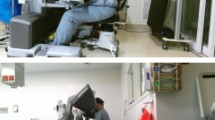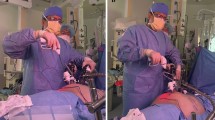Abstract
Ergonomics is essential in surgical practice and especially in minimally invasive surgery (MIS) due to concerns with dexterity, loss of 3D view, fulcrum effect and longer duration. This paper aims to audit the ergonomic practice amongst minimally invasive surgeons in Bangalore, India. In this audit, personal assessments of surgeons were done while they were performing surgery based on accepted ergonomic practice guidelines, after taking their consent. The assessment data included demographics, surgeon’s posture and operating room configurations. Of the 51 surgeons who were assessed, 17 (33%) of them reported history of musculoskeletal problems. Majority (more than 75%) of surgeons followed proper ergonomics when keeping themselves in line with target organ and monitor, maintaining proper angles at the elbow joint and forearm. More than 80% of operating rooms had appropriately functioning tables and instruments. Less than 50% of surgeons maintained proper head and neck posture. Monitor height was more than the operating MIS surgeon’s height in 43% of operating rooms. Although many surgeons showed good ergonomic practice overall, it was found that there were a few areas for improvement with respect to the ideal posture. Our recommendations include adjusting height of the monitor with respect to the surgeon’s height by use of foot stools or by updating operating rooms with ceiling suspended monitors, height adjustments of the operating table to facilitate maintenance of pelvic girdle symmetry with equal weight distribution while standing. Surgeons must also be advised to be aware of the prolonged and extreme degrees of joint movements and correct them accordingly.




Similar content being viewed by others
References
Supe AN, Kulkarni GV, Supe PA (2010) Ergonomics in laparoscopic surgery. J Minim Access Surg 6(2):31
McCormick EJ, Sanders MS (1993) Human factors in engineering and design. McGraw-Hill Companies, New York
Yeola G (2017) Ergonomics in laparoscopy. Int J Recent Surg Med Sci 3(02):102–108
Van Det MJ, Meijerink WJHJ, Hoff C, Totte ER, Pierie JPEN (2009) Optimal ergonomics for laparoscopic surgery in minimally invasive surgery suites: a review and guidelines. Surg Endosc 23(6):1279–1285
Van Veelen MA, Nederlof EAL, Goossens RHM, Schot CJ, Jakimowicz JJ (2003) Ergonomic problems encountered by the medical team related to products used for minimally invasive surgery. Surg Endosc Other Interv Tech 17(7):1077–1081
Higgins RM, Frelich MJ, Bosler ME, Gould JC (2017) Cost analysis of robotic versus laparoscopic general surgery procedures. Surg Endosc 31(1):185–192
Goossens HM, Van Veelen MA (2001) Assessment of ergonomics in laparoscopic surgery. Minim Invasive Ther Allied Technol 10(3):175–179
Wauben LSGL, Van Veelen MA, Gossot D, Goossens RHM (2006) Application of ergonomic guidelines during minimally invasive surgery: a questionnaire survey of 284 surgeons. Surg Endosc Other Interv Tech 20(8):1268–1274
Dabholkar T, Yardi S, Dabholkar YG, Khanvilkar A (2015) Work related musculoskeletal disorders in surgeons performing minimal invasive procedures in Mumbai & Navi Mumbai India. Int J Health Sci Res 5(8):347–355
Berguer R (2006) Ergonomics in laparoscopic surgery. In: Whelan RL, Fleshman JW, Fowler DL (eds) The sages manual. Springer, New York
Sánchez-Margallo FM, Sánchez-Margallo JA (2017) Ergonomics in laparoscopic surgery. Laparoscopic Surgery. InTech, Rijeka, pp 105–123
Zahiri HR, Addo A, Park AE (2019) Musculoskeletal disorders in minimally invasive surgery. Adv Surg 53:209–220
Stucky CCH, Cromwell KD, Voss RK, Chiang YJ, Woodman K, Lee JE, Cormier JN (2018) Surgeon symptoms, strain, and selections: systematic review and meta-analysis of surgical ergonomics. Ann Med Surg 27:1–8
Liang B, Qi L, Yang J, Cao Z, Zu X, Liu L, Wang L (2013) Ergonomic status of laparoscopic urologic surgery: survey results from 241 urologic surgeons in China. PLoS One 8(7):e70423
Modi YS, Kuswaha MR, Dave SP (2013) Awareness of Ergonomic Guidelines regarding laparoscopic surgeries, its Practice among Surgeons and Comfort level during and after surgery. Med J 68:31–34
Aitchison LP, Cui CK, Arnold A, Nesbitt-Hawes E, Abbott J (2016) The ergonomics of laparoscopic surgery: a quantitative study of the time and motion of laparoscopic surgeons in live surgical environments. Surg Endosc 30(11):5068–5076
Stomberg MW, Tronstad SE, Hedberg K, Bengtsson J, Jonsson P, Johansen L, Lindvall B (2010) Work-related musculoskeletal disorders when performing laparoscopic surgery. Surg Laparosc Endosc Percutan Tech 20(1):49–53
Acknowledgements
We thank Dr. H R Ravishankar, Dr. Srikanth K N, Dr. Sachin D Nale, Dr. H V Rajashekara Reddy, Dr. Ananth Krishna, Dr. Ameen and Dr. Abdul for their efforts in obtaining consent from surgeons and access for assessments. We also thank Dr. Swaroop (Biostatistician) for his help with statistical analysis of the data.
Author information
Authors and Affiliations
Corresponding author
Ethics declarations
Conflict of Interest
The authors declare that they have no conflict of interest.
Informed Consent
Informed consent was obtained from all surgeons included in the study.
Additional information
Publisher’s Note
Springer Nature remains neutral with regard to jurisdictional claims in published maps and institutional affiliations.
Key Points
• Minimally invasive surgery requires a high degree of physical inputs from the operating surgeons who are generally used to open surgery.
• Proper ergonomic practice helps to avoid musculoskeletal problems.
• But knowledge of and compliance to proper ergonomic practice is lower amongst the minimally invasive surgeons because of which musculoskeletal problems are on rise with the growing number of procedures.
Rights and permissions
About this article
Cite this article
Chohatakar, H.A., Ramesh, V., Paramashivaiah, N. et al. Minimally Invasive Surgery: Are We Doing It Right?. Indian J Surg 83, 1185–1191 (2021). https://doi.org/10.1007/s12262-020-02612-1
Received:
Accepted:
Published:
Issue Date:
DOI: https://doi.org/10.1007/s12262-020-02612-1




